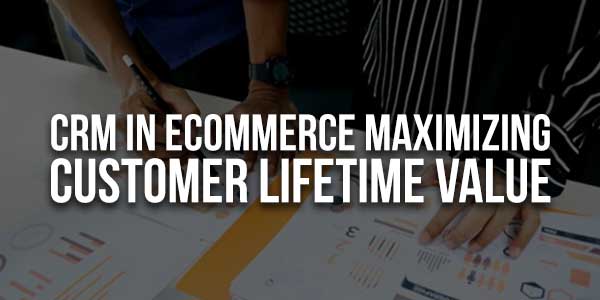
It is impossible to secure the long-term patronage of a customer if you do not nurture your connection with them. This makes it imperative to pay close attention to CRM in e-commerce since it is the surest path to maximizing customer lifetime value.
Table of Contents
Understanding The Customer’s Lifetime Value:
Understanding customer lifetime value (CLV) is pivotal for businesses aiming to boost e-commerce sales. CLV represents the total revenue a client is expected to generate throughout their relationship with a brand. By comprehending this metric, companies can make informed decisions on marketing strategies, client retention efforts, and product offerings. Essentially, CLV guides businesses in distinguishing between high-value and low-value clients, enabling them to allocate resources more effectively. It allows for personalized marketing campaigns and tailoring product recommendations, which enhances the customer experience and fosters loyalty. As a result, boosting CLV leads to increased revenue, improved profitability, and sustainable growth, making it a fundamental concept for any e-commerce enterprise looking to thrive in the competitive online landscape. And implementing CRM in e-commerce makes it much easier for people to track CLV effectively!
Benefits Of Maximizing CLV:
Maximizing Customer Lifetime Value offers a multitude of benefits for businesses in the competitive world of e-commerce:
- Increasing revenue and profitability by focusing on high-value clients who consistently contribute more to the bottom line.
- Fostering enhanced client loyalty and retention. By understanding the preferences and behavior of people, businesses can tailor their products and services, providing a personalized experience that keeps them coming back. This loyalty boosts sales and reduces the need for expensive buyer acquisition efforts.
- Prioritizing CLV is cost-effective, as retaining existing customers is more affordable than acquiring new ones.
- Streamlining marketing efforts, which ensure resources are allocated efficiently.
Maximizing CLV is a strategic approach that drives financial success and strengthens the bond between businesses and their clients, creating a win-win situation in e-commerce.
Implementing CRM In E-Commerce:
Implementing CRM in e-commerce is a strategic imperative for businesses seeking to thrive in the digital marketplace. To begin, choosing the right CRM software is pivotal, as it acts as the backbone of client data management and engagement. With the right CRM solution, businesses can use effective data collection and segmentation, organizing client information for personalized interactions. This personalization, facilitated by CRM, helps create a 360-degree customer view, allowing businesses to understand client preferences and behaviors across various touchpoints. In turn, this enables predictive analytics for Customer Lifetime Value estimation, aiding in long-term client relationship planning.

Creating A 360-Degree Customer View:
Creating a comprehensive 360-degree customer view is a strategic imperative for businesses aiming to excel. This approach integrates data from various touchpoints where buyers interact with the brand, including websites, social media, emails, and in-store visits. Businesses gain valuable insights into customer behavior, preferences, and purchasing habits when analyzing this information. This holistic understanding allows for delivering highly personalized experiences, tailored product recommendations, and targeted marketing campaigns. Moreover, a 360-degree customer view is instrumental in forecasting future trends and customer lifetime value. It enables businesses to identify their most valuable clients and nurture those relationships, thus fostering long-term loyalty and profitability.
Building Customer Loyalty Programs:
Building effective loyalty programs can significantly improve your e-commerce business. These programs are pivotal in nurturing buyer relationships and fostering long-term loyalty. They come in various forms, such as points-based systems, tiered rewards, or exclusive memberships, all designed to incentivize repeat purchases and engagement. Businesses can create a sense of exclusivity and value by offering tangible benefits like discounts, freebies, or early access to new products. So, these programs boost buyer retention and encourage people to spend more, thereby increasing the average order value. Furthermore, loyalty programs provide valuable data and insights into buyer behavior, allowing businesses to effectively tailor their offerings and marketing efforts.
Customer Support And CRM:
In the realm of e-commerce, the integration of customer support and CRM is pivotal. CRM tools facilitate efficient customer support by providing agents with comprehensive buyer data, enabling them to offer personalized assistance and resolve issues promptly. This not only enhances the shopping experience but also boosts satisfaction and loyalty. CRM systems also streamline support ticket management, ensuring no buyer concern falls through the cracks. Furthermore, leveraging CRM data allows businesses to identify common pain points and work on permanent solutions proactively. Thus reducing the need for repeated support interactions.
Retention Metrics And KPIs:
Retention metrics and Key Performance Indicators (KPIs) guide e-commerce businesses toward sustained success. These metrics provide crucial insights into buyer behavior, satisfaction, and loyalty. Key indicators include churn rates, which reveal the percentage of customers leaving within a specific time frame. A low churn rate signifies healthy buyer retention. Additionally, monitoring metrics like Customer Lifetime Value (CLV) and Net Promoter Score (NPS) helps gauge the success of your business. High CLV suggests that buyers are generating significant revenue over their lifetimes. Meanwhile, a positive NPS indicates satisfied buyers will likely recommend the brand. Conducting satisfaction surveys further refines insights, allowing businesses to fine-tune their strategies and address pain points proactively.
Challenges And Pitfalls In CRM Implementation:
Challenges and pitfalls often accompany the implementation of CRM in e-commerce. One significant challenge is data privacy and security concerns, as safeguarding private information is paramount. Overpersonalization is another pitfall, where businesses risk overwhelming people with hyper-personalized content, potentially breaching their privacy. Moreover, CRM implementation sometimes alienates buyers if not executed thoughtfully, causing them to perceive it as intrusive rather than helpful. It’s also important to recognize that CRM is not a one-time endeavor as it requires ongoing dedication, much like implementing SEO for e-commerce. So, ensuring that CRM strategies adapt to changing demands and market dynamics is key to long-term success. These challenges and pitfalls remind us that while CRM can yield substantial benefits, planning, and continuous refinement are necessary.
Prioritizing CRM In E-Commerce:
With CRM in e-commerce, maximizing customer lifetime value becomes possible. So, this is definitely a field you can never allow yourself to ignore.

 About the Author:
About the Author:
















Be the first to write a comment.